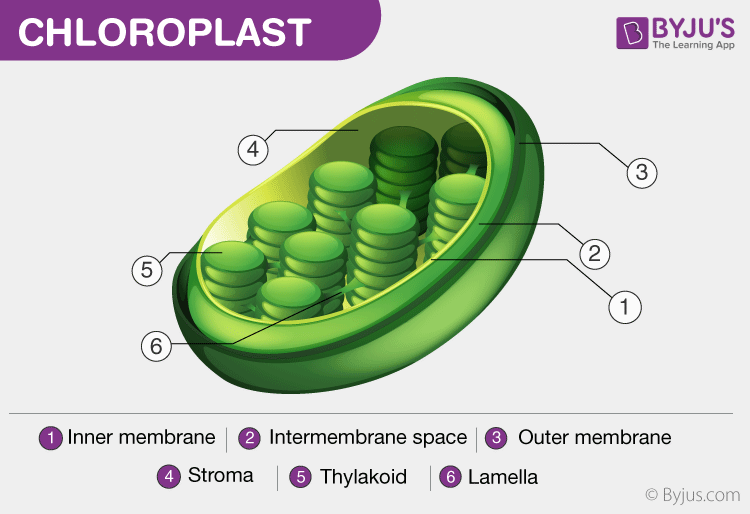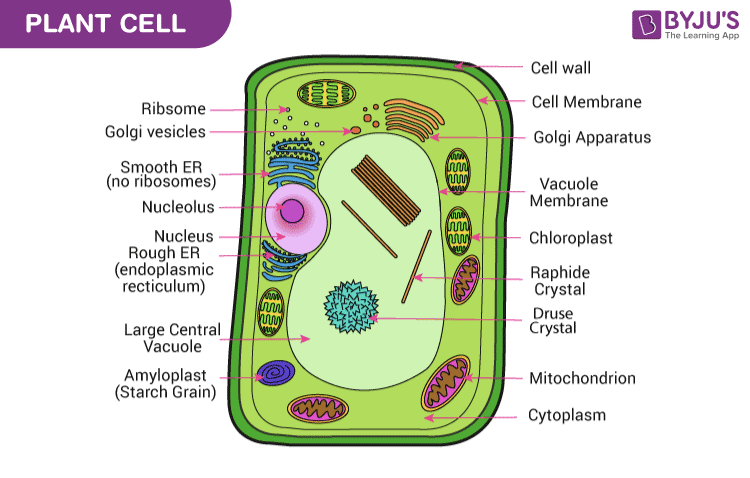23. Would This Experiment Work With Other Plant Cells? What About With Animal Cells? Why Or Why Not?
The prison cell is the bones unit of life in all organisms. Similar humans and animals, plants are besides composed of several cells. The plant jail cell is surrounded by a cell wall which is involved in providing shape to the plant cell. Autonomously from the cell wall, in that location are other organelles that are associated with different cellular activities.
Let u.s.a. have a detailed look at the plant cell, its structure, and the functions of different found cell organelles.
Plant Cell Definition
"Plant cells are eukaryotic cells with a true nucleus along with specialized structures chosen organelles that carry out certain specific functions."
Table of Contents
- What is a Plant Cell?
- Institute Cell Diagram
- Plant Jail cell Structure
- Plant Cell Types
- Plant Cell Functions
What is a Plant Prison cell?
Institute cells are eukaryotic cells that vary in several fundamental factors from other eukaryotic organisms. Both establish and creature cells contain a nucleus forth with like organelles. I of the distinctive aspects of a plant jail cell is the presence of a cell wall outside the cell membrane.
Read more: Cells
Constitute Cell Diagram
The plant cell is rectangular and insufficiently larger than the animal cell. Fifty-fifty though plant and animal cells are eukaryotic and share a few cell organelles, plant cells are quite singled-out when compared to fauna cells every bit they perform different functions. Some of these differences tin can be conspicuously understood when the cells are examined under an electron microscope.
Also Read:Cellulose in Digestion
Found Jail cell Structure
Just like unlike organs within the trunk, plant cell structure includes various components known equally cell organelles that perform different functions to sustain itself. These organelles include:
Prison cell Wall
Information technology is a rigid layer which is composed of polysaccharides cellulose, pectin and hemicellulose. Information technology is located exterior the cell membrane. It also comprises glycoproteins and polymers such equally lignin, cutin, or suberin.
The primary part of the cell wall is to protect and provide structural support to the cell. The institute cell wall is too involved in protecting the cell confronting mechanical stress and providing form and structure to the prison cell. It too filters the molecules passing in and out of it.
The formation of the cell wall is guided by microtubules. It consists of three layers, namely, master, secondary and the heart lamella. The primary cell wall is formed by cellulose laid downwardly past enzymes.
Also Read:Prison cell Wall
Jail cell membrane
It is the semi-permeable membrane that is present within the cell wall. It is composed of a sparse layer of protein and fat.
The cell membrane plays an important function in regulating the entry and exit of specific substances inside the prison cell.
For example, cell membrane keeps toxins from inbound within, while nutrients and essential minerals are transported beyond.
Also Read:Cell Wall and Cell Membrane
Nucleus
The nucleus is a membrane-bound construction that is present only in eukaryotic cells. The vital function of a nucleus is to shop DNA or hereditary information required for prison cell division, metabolism and growth.
- Nucleolus: It manufactures cells' poly peptide-producing structures and ribosomes.
- Nucleopore: Nuclear membrane is perforated with holes called nucleopore that allow proteins and nucleic acids to pass through.
Explore more:The Nucleus
Plastids
They are membrane-bound organelles that have their ain DNA. They are necessary to store starch and to deport out the procedure of photosynthesis. It is likewise used in the synthesis of many molecules, which form the edifice blocks of the prison cell. Some of the vital types of plastids and their functions are stated below:
Leucoplasts
They are found in the not-photosynthetic tissue of plants. They are used for the storage of protein, lipid and starch.
Chloroplasts
Information technology is an elongated organelle enclosed by phospholipid membrane. The chloroplast is shaped similar a disc and the stroma is the fluid within the chloroplast that comprises a circular DNA. Each chloroplast contains a green coloured pigment called chlorophyll required for the process of photosynthesis. The chlorophyll absorbs calorie-free energy from the sun and uses it to transform carbon dioxide and water into glucose.
Too Read:Chloroplasts

Chromoplasts
They are heterogeneous, coloured plastid which is responsible for pigment synthesis and for storage in photosynthetic eukaryotic organisms. Chromoplasts have ruddy, orange and yellow coloured pigments which provide colour to all ripe fruits and flowers.
Central Vacuole
It occupies around 30% of the cell'due south book in a mature plant prison cell. Tonoplast is a membrane that surrounds the fundamental vacuole. The vital function of the central vacuole apart from storage is to sustain turgor pressure against the cell wall. The fundamental vacuole consists of prison cell sap. Information technology is a mixture of salts, enzymes and other substances.
Also read:Vacuoles
Golgi Appliance
They are constitute in all eukaryotic cells, which are involved in distributing synthesised macromolecules to various parts of the prison cell.
Explore more than:Golgi Apparatus
Ribosomes
They are the smallest membrane-bound organelles which comprise RNA and protein. They are the sites for protein synthesis, hence, also referred to as the protein factories of the prison cell.
Explore more:Ribosomes
Mitochondria
They are the double-membraned organelles found in the cytoplasm of all eukaryotic cells. They provide energy by breaking down sugar and sugar molecules, hence they are likewise referred to equally the "Powerhouse of the cell."
Explore more:Mitochondria
Lysosome
Lysosomes are called suicidal numberless every bit they hold digestive enzymes in an enclosed membrane. They perform the function of cellular waste disposal by digesting worn-out organelles, food particles and strange bodies in the prison cell. In plants, the role of lysosomes is undertaken by the vacuoles.
Also read:Lysosomes
Plant Jail cell Types
Cells of a matured and college plant become specialised to perform certain vital functions that are essential for their survival. Few found cells are involved in the transportation of nutrients and h2o, while others for storing food.
The specialised plant cells include parenchyma cells, sclerenchyma cells, collenchyma cells, xylem cells and phloem cells.
Following are some of the unlike types of plant cells:
Collenchyma Cells
They are hard or rigid cells, which play a principal role in providing back up to the plants when there is restraining growth in a establish due to lack of hardening amanuensis in master walls.
Sclerenchyma Cells
These cells are more rigid compared to collenchyma cells and this is considering of the presence of a hardening amanuensis. These cells are usually found in all found roots and mainly involved in providing support to the plants.
Parenchyma Cells
Parenchyma cells play a significant part in all plants. They are the living cells of plants, which are involved in the production of leaves. They are also involved in theexchange of gases, production of food, storage of organic products and cell metabolism. These cells are typically more flexible than others because they are thinner.
Xylem Cells
Xylem cells are the transport cells in vascular plants. They help in the send of water and minerals from the roots to the leaves and other parts of the plants.
Phloem Cells
Phloem cells are other ship cells in vascular plants. They transport food prepared by the leaves to different parts of the plants.
Refer more: Plant Tissue Organisation
Institute Jail cell Functions
Plant cells are the building blocks of plants. Photosynthesis is the major function performed by plant cells.
Photosynthesis occurs in the chloroplasts of the establish cell. Information technology is the process of preparing food by the plants, by utilising sunlight, carbon dioxide and water. Energy is produced in the form of ATP in the procedure.
A few plant cells help in the transport of water and nutrients from the roots and leaves to different parts of the plants.
To more than near a plant prison cell, its definition, structure, diagram, types and functions, keep visiting BYJU'S Biology website or download BYJU'S app for further reference.
Often Asked Questions
What is a institute cell?
A institute cell is a eukaryotic prison cell that contains a true nucleus and certain organelles to perform specific functions. However, some of the organelles nowadays in plant cells are unlike from other eukaryotic cells.
What are the different types of found cells?
The different types of found cells include- collenchyma, sclerenchyma, parenchyma, xylem and phloem.
Which organelles are institute only in plant cells?
The organelles plant only in establish cells include- chloroplast, jail cell wall, plastids, and a large central vacuole. The chloroplasts contain a green pigment chlorophyll that is responsible for the process of photosynthesis.
What is the limerick of a plant jail cell wall?
The cell wall of a plant is made up of cellulose. Cellulose is a long, linear polymer of several glucose molecules.
Where does photosynthesis occur in constitute cells?
Photosynthesis occurs within the chloroplast of the plant cells. Chloroplast consists of a light-green paint called chlorophyll. The lite reactions occur within the thylakoids of the chloroplast where the chlorophyll pigment is found.
Source: https://byjus.com/biology/plant-cell/
Posted by: rosssoombeark.blogspot.com


0 Response to "23. Would This Experiment Work With Other Plant Cells? What About With Animal Cells? Why Or Why Not?"
Post a Comment